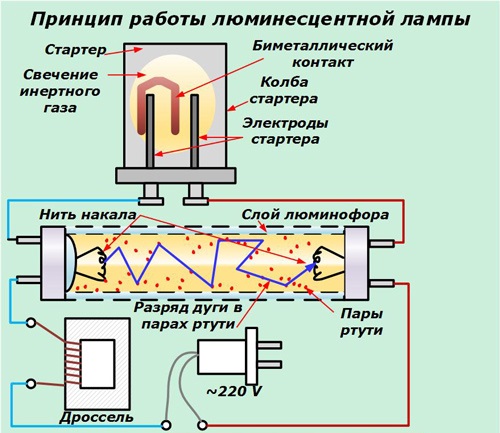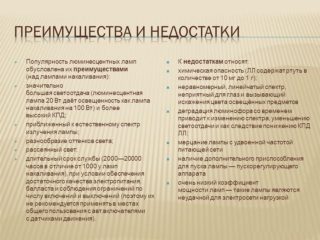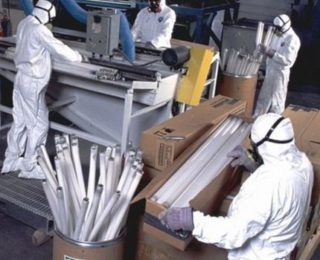Saving energy is the most important task for any owner of a house or apartment. In order to save money, there is a transition to energy-saving lamps, which include fluorescent lamps. Luminescent light sources are actively used both in residential buildings and for illuminating office buildings or warehouses. Before purchasing a device, you need to understand what advantage fluorescent lamps have over incandescent lamps, what technical characteristics they have and what types of devices are.
Fluorescent lamp device and principle of operation
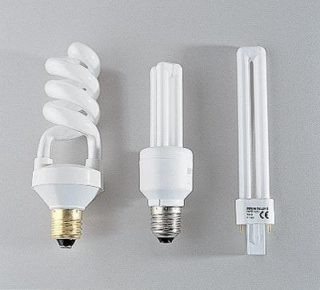
A fluorescent lamp is a device that is used to create lighting. The luminaire has a number of structural similarities with classic incandescent or halogen lamps. To understand what a fluorescent lamp is, you need to understand its structure. The luminescent device consists of a sealed bulb and electrodes. The sturdy glass bulb contains a mixture of gases and mercury, the inner part is covered with a phosphor. Tungsten filament electrodes are installed along the edges, to which current-carrying contacts are soldered.
An electric current is supplied, which flows to the electrodes. The filament heats up, resulting in a discharge accompanied by ultraviolet radiation. This glow passes through the walls of the flask, a phosphor and turns into ordinary visible light.
Due to the presence of mercury and other harmful substances in the composition, the LL lamp must be handled carefully, trying not to damage it. It is forbidden to dispose of it as ordinary household waste - a fluorescent lamp, like a halogen one, is handed over to a special collection point.
Light source characteristics
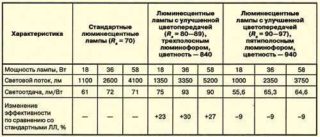
Fluorescent lamps have more than technical characteristics. Like any electrical product, they have electrical characteristics, and as a lighting device, they have light parameters.
Electrical characteristics include:
- Rated voltage. Mains voltage suitable for lamp operation. Is 220 V or 110 V.
- Working voltage. The value on the lamp while it is burning. It is equal to half the nominal and is 100-110 V for a 220 V network and 45-60 V for 110 V.
- Ignition voltage. The value on the bulb required for the discharge to appear. It is significantly higher than the network value and is not constant. Depends on ignition circuit, environmental conditions.
- Rated power. According to this indicator, low-power (up to 18 W), medium power (up to 58 W) and powerful (from 58 W) devices are distinguished. High-intensity light bulbs with a power of 150 W can also be found on sale, but they are practically not used due to their low efficiency.
- Efficiency. Fluorescent lighting has an efficiency in excess of 20%.
- The diameter of the flask is 12.16.26.38 mm.
- Plinth sizes 14 and 27 mm.
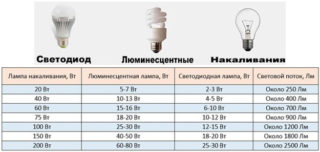
Lighting characteristics of discharge lamps:
- Nominal luminous flux. Set 100 hours after burning.
- Color rendering index. Depends on the lamp version. In standard devices it is 50-70%, in lamps with increased color rendering it is 97%.
- Colorful temperature. Shows what shade the glow will have. Fluorescent lamps are manufactured in the range from 2700 K to 6500 K.
Performance characteristics:
- Luminous efficiency depends on color and power. Household lamps LB 40 W - 80 lm / W have the greatest. Of the lamps produced, the maximum luminous efficiency of the T5 series with electronic ballast is 104 lm / W.
- Average burning time. Depends on the electrodes and the strength of the oxide film covering them. Medium power lamps have a duration of 15,000 hours.
- Ripple factor. In most fluorescent lamps, it is 23%, except for devices with improved color rendering, which reaches 70%.
- Dependence on ambient temperature. At low temperatures, ignition conditions deteriorate. The operating temperature range is 5 to 55 ° C.
- Disposal. Since the lamp contains mercury and other harmful components, it must be disposed of in a special way. To do this, the device must be taken and handed over to a special collection point.
In terms of their characteristics, fluorescent light sources are significantly superior to classic bulbs.
The main types of fluorescent lamps
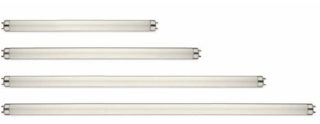
Fluorescent light sources can be divided into the following groups:
- Linear. They are used to illuminate offices, warehouses, industries, sports grounds. They have increased power and light output. They save about 30% of electricity.
- Compact. Also in everyday life they are called energy-saving. They look like ordinary light bulbs. Used for general purpose in classic luminaires. Also found their application in the illumination of advertising showcases, hospital premises. They have an increased service life and high luminous efficiency.
Also, the lamps can be divided as follows:
- Standard. The inside of the flask is covered with one layer of phosphor. Used in home lamps, tabletop lighting devices.
- With increased light transmission. They have a three-layer or five-layer phosphor.
- Special. Various components can be added to the phosphor. They are used in show business, tanning salons, in bactericidal lamps.
The most common types are high and low pressure mercury discharge lamps. High pressure devices are used in street lighting and high power luminaires. Low pressure lamps have found application in the lighting of residential premises and industrial enterprises.
The choice of the type of lamp directly depends on the luminaire in which it will be used and on its purpose.
Connecting to the network
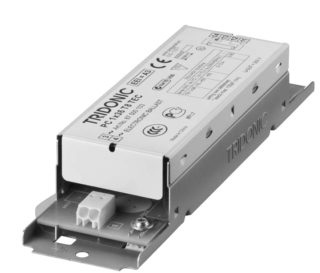
Discharge lamps cannot be directly connected to the mains due to high cold resistance and negative differential resistance.
These problems can be corrected by applying ballasts. The most common are EMPRA (electromagnetic ballast) and electronic ballast (electronic).
EMPRA is an electromagnetic choke that is connected in series with the lamp. A starter is connected in series with the heating coils, which is a neon lamp with bimetallic electrodes and a capacitor. Advantages - simplicity of design, reliability, durability. Disadvantages - long start-up, a large amount of electricity is required, hum during operation, flickering, large size.
The electronic ballast supplies the light bulb with high-frequency voltage, thereby eliminating flashing. Uses two options for starting lamps:
- Cold. The luminaire is switched on immediately after energizing.
- Hot. The electrodes are warmed up and the source lights up in 0.5-1 second.
The advantages include a long service life, less power consumption, the ability to dim on some models, and noiselessness.
LL marking
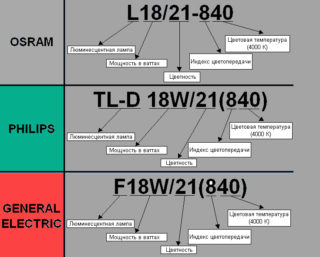
There are two types of lamp markings that differ from each other: domestic and foreign.
The Russian designation consists of a set of letters and numbers. The definition of decryption is as follows:
- The first letter L stands for a lamp.
- The second letter denotes the luminous flux characteristic. D - daytime, HB - cold white, TB - warm white, EB - natural, B - white, UV - ultraviolet, C - blue, K - red, H - green, D - blue, F - yellow.
- The third sign is the quality of color rendering. C - increased, CZ - the best.
- The fourth symbol denotes a construction. A - amalgam, K - annular, R - reflex, B - quick start, U - U-shaped.
- The last figures are the wattage.
Also, the lamp may have the abbreviation LHE or LE. It stands for natural or cool natural light.
Foreign labeling consists of a three-digit number and an English signature like cool white. You can find designations in tables.
Pros and cons of fluorescent lamps
- energy saving;
- high quality light;
- good light output;
- a wide range of products for general and special purposes;
- duration of operation - the norm is 10-40 thousand hours;
- if it burns out, the bulb is easy to change.
Disadvantages:
- Cost. First of all, you need to calculate what budget will be spent on installing fluorescent devices instead of classic light sources. It is quite costly, but due to the duration of the work, the money will quickly pay off.
- Negative effect on human health with prolonged lighting. Damage to the eyes.
- Service life versus the number of on and off cycles.
- High risk of breakage due to power surges. Requires installation of a stabilizer or other surge protection device. Otherwise, the device may burn out.
- Dimmer incompatibility.
Lamps are hazardous to human health due to the presence of mercury. - Noisy work. The light can beep quite loudly, which can make people in the room uncomfortable.
- Impossible to use in dusty and damp areas. Outdoor work requires a high degree of protection against dust and water.
- Danger due to the presence of mercury.
- Flask fragility.
- The need for heat dissipation.
- Poor performance at low temperatures.
- The choice of the glow color of LED lamps is greater than that of fluorescent backlighting.
The product has many drawbacks, but if the operating conditions are observed, the lamp will glow for the declared period.
Applications
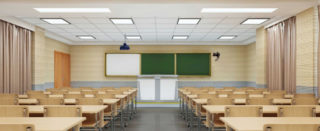
Fluorescent light is used almost everywhere. This is the illumination of houses, shop windows, aquariums, non-residential premises, streets. Fluorescent and neon lighting is actively used in various performances and concerts. Also, light sources can be used to create plasma TV screens and computers.
The main area of application is the illumination of large areas. Stadiums, playgrounds, courtyards are illuminated precisely by fluorescent devices with a dust and moisture protection housing. This is due to the high luminous efficacy and the minimum number of on and off cycles - it is enough to turn on the light bulbs once a day at night.

